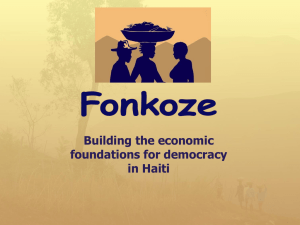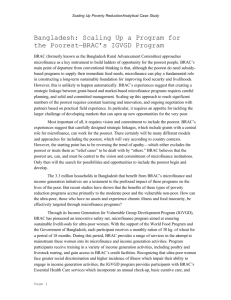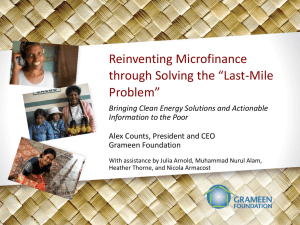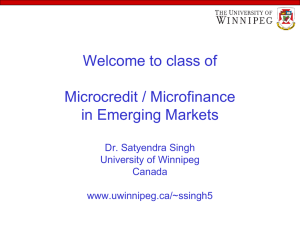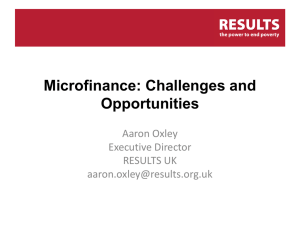Karishma Huda, Brac Development Institute
advertisement
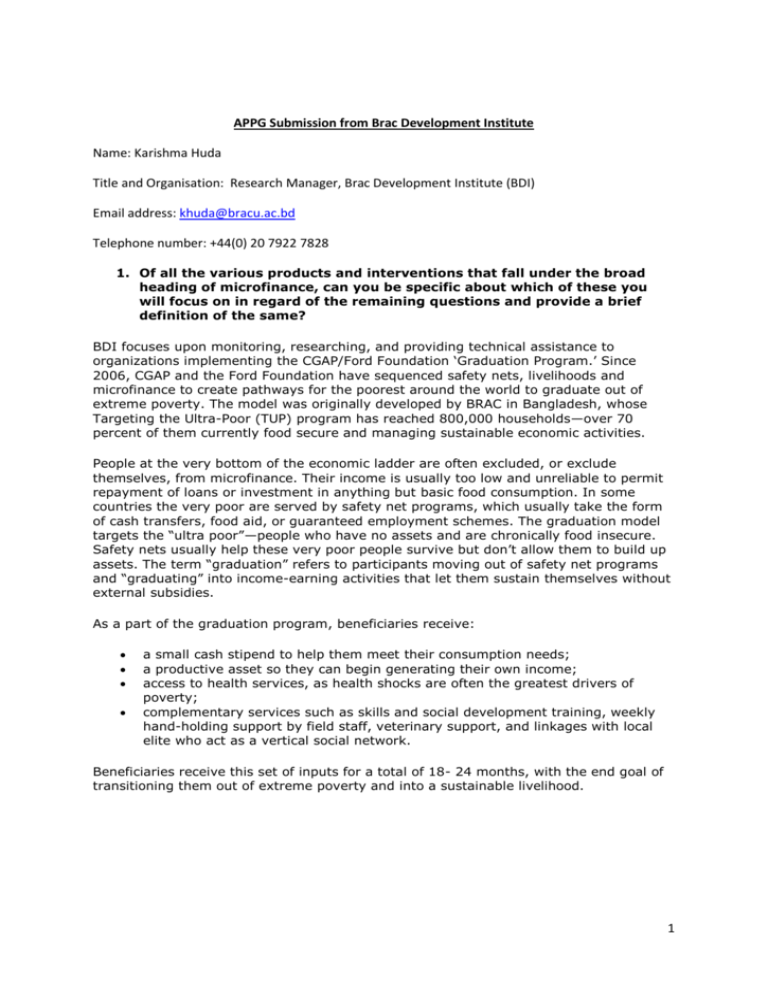
APPG Submission from Brac Development Institute Name: Karishma Huda Title and Organisation: Research Manager, Brac Development Institute (BDI) Email address: khuda@bracu.ac.bd Telephone number: +44(0) 20 7922 7828 1. Of all the various products and interventions that fall under the broad heading of microfinance, can you be specific about which of these you will focus on in regard of the remaining questions and provide a brief definition of the same? BDI focuses upon monitoring, researching, and providing technical assistance to organizations implementing the CGAP/Ford Foundation ‘Graduation Program.’ Since 2006, CGAP and the Ford Foundation have sequenced safety nets, livelihoods and microfinance to create pathways for the poorest around the world to graduate out of extreme poverty. The model was originally developed by BRAC in Bangladesh, whose Targeting the Ultra-Poor (TUP) program has reached 800,000 households—over 70 percent of them currently food secure and managing sustainable economic activities. People at the very bottom of the economic ladder are often excluded, or exclude themselves, from microfinance. Their income is usually too low and unreliable to permit repayment of loans or investment in anything but basic food consumption. In some countries the very poor are served by safety net programs, which usually take the form of cash transfers, food aid, or guaranteed employment schemes. The graduation model targets the “ultra poor”—people who have no assets and are chronically food insecure. Safety nets usually help these very poor people survive but don’t allow them to build up assets. The term “graduation” refers to participants moving out of safety net programs and “graduating” into income-earning activities that let them sustain themselves without external subsidies. As a part of the graduation program, beneficiaries receive: a small cash stipend to help them meet their consumption needs; a productive asset so they can begin generating their own income; access to health services, as health shocks are often the greatest drivers of poverty; complementary services such as skills and social development training, weekly hand-holding support by field staff, veterinary support, and linkages with local elite who act as a vertical social network. Beneficiaries receive this set of inputs for a total of 18- 24 months, with the end goal of transitioning them out of extreme poverty and into a sustainable livelihood. 1 The frontiers, however, are still being tested. Ten graduation pilots are underway in Ethiopia, Haiti, Honduras, India, Pakistan, Peru, Yemen, and Ghana, involving diverse institutional forms, economic contexts, and cultures. They are being rigorously researched through randomized control trials and qualitative ethnographic methods. The pilots are implemented through partnerships among financial service providers, nongovernmental organizations (NGOs), and government safety net programs. 2. Should the reduction of poverty be the primary goal of all microfinance programmes? Not necessarily. The primary goal of microfinance should be upon financial inclusion. Poverty reduction requires more than just credit, and must take a holistic approach by tackling education, health, food security, rights awareness, etc. Rather, microfinance is about opening up the frontier of finance so that conventionally excluded people (e.g. indigenous groups, the destitute, remote populations, etc) are brought into the financial services sphere. Given that, it has been recognized is that credit on its own does not always reach these marginalized groups, particularly the poorest. Although microfinance provides a much needed boost to those with existing businesses and skills, the extreme poor are often excluded because their livelihoods are too insecure and vulnerable. This essentially means that they are too risky for the MFI, and the extreme poor are themselves risk adverse and often self-select themselves out of a loan program. In the same vein, savings led organisations generally accumulate minimal savings, and thus do not accumulate large enough cash reserves to lend out significant amounts to members The remit of the graduation programme, therefore, is to link up credit up to social protection and create pathways that lead to sustainable livelihoods that can then lead up to the financial sector. The programme posits that the poorest must have their most basic needs met before they can begin to realise their economic potential. Through promotional activities, such as providing them with an enterprise (through a grant rather than a loan), business training, and active savings, the extreme poor learn to harness their financial potential in a risk-free environment. However, given that the extreme poor are most susceptible to shocks, they are given ‘breathing space’ through a consumption stipend, health services and personal mentoring through a field agent. This combination of protective and promotional elements creates an environment where the extreme poor 2 can learn how to effectively utilise a loan, and graduate into microfinance. Realising that there is a limit to microfinance and the poorest do not need credit thrust upon them, the primary goal is about expanding financial access slowly and carefully. 3. What factors make microfinance successful in alleviating poverty? Firstly, it should be noted that perhaps the greatest disservice to microfinance stems from over enthusiastic advocates claiming it to be a magic bullet for client economic improvements and poverty alleviation. The real raison d’être of microfinance is about financial sector deepening, about opening access to the nearly three billion people in the world still without formal financial services, it is about providing a range of services – credit, savings, remittances, domestic transfers, insurance, pensions, etc – that we take for granted, but that is unavailable to the majority of the world. And even with credit and savings, it is not just about borrowing to set up economic enterprises. It is about payment for school and books, for health emergencies, for buying food stock when prices are low, for travel to the city to look for employment, and so many other activities that we use finance for. It is really about ensuring poor people have the same access and the same choices in the financial sector that we the privileged have. It is about democratizing the financial sector, which inextricably positively affects poverty alleviation. With that being said, the graduation model, as implemented by BRAC and CGAP/Ford Foundation, have had poverty alleviation at the core of their social mission -- BRAC with acclaimed success and the pilots testing the frontiers. The following are a few key elements that have contributed: Targeting of female headed households: Poverty has a distinctly gendered face: maternal ill health leads to the birth of malnourished babies, who begin their lives with serious anthropometric disadvantages that are irreversible given the deprivation of this geographic context. In Haiti, Africa as well as South Asia, women often experience abandonment and thus form the backbone of the household economy. The crux of tackling poverty for this demographic, therefore, has been the targeting female headed households and empowering women to take ownership of loans and enterprise assets. Human rights/social development components: BRAC has always been privy to the fact that poverty is multi-dimensional, and thus social and not just economic facets must be addressed if one is to influence extreme poverty. BRAC incorporates access to legal aid, counselling on domestic violence, and rights awareness to their lending and TUP activities. Learning from BRAC, the graduation pilots have also incorporated social messaging, personal coaching, and ‘village committees.’ Village committees are groups of local elite that act as a vertical social network for clients and beneficiaries, helping them with personal shocks such as funeral/wedding expenses, rebuilding homes after a natural disaster, etc. Since field staff can only visit clients on a weekly basis, village committee members provide ongoing and localised assistance to help members stay on track. South-south learning: a factor in microfinance being successful is the MFI having an understanding of local poverty contexts. BRAC has been a pioneer in microfinance and livelihood activities in Bangladesh, and they have lent this local, on the ground expertise to the ten implementing graduation pilots through exposure visits, technical assistance, training, etc. Southern organisations from Fonkoze in Haiti to Social Welfare Fund in Yemen have utilised these grounded 3 realities to design their interventions. This model of South South learning has lent well to effective, localised poverty alleviation strategies. Disaster management preparedness: Natural and manmade disasters are a major force in perpetuating and exacerbating existing structures and conditions of poverty. Microfinance organisations are often able to mobilise and reach poor communities faster and more effectively than international agencies. When the devastating earthquake hit Haiti in January 2010 and commercial banking operations had shut down, Haiti’s largest MFI, Fonkoze, was the only source of cash and remittances that existed in the country. When international NGO staff had fled, Fonkoze staff had set up a makeshift tent out of which millions of Haitian Gourdes were being disbursed on a daily basis. Their vehicles were able to provide aid to extreme poor graduation beneficiaries immediately in locations so remote, international agencies a year after the disaster are still yet to have a presence. Microfinance, therefore, plays a tremendous role in disaster relief and prevention. 4. Which groups should or should not be targeted by microfinance programmes and why? (For example: the economically active poor, the poorest, etc). All groups of the poor should be targeted by microfinance programmes, but they should be carefully selected to ensure that they are receiving the products and services that cater to their needs. Through a rigorous targeting process that involves three strands of knowledge -- community perceptions (participatory methods to get a localised understanding of who the poorest are), programmatic criteria (who does the programme seek to include and exclude) and poverty scorecards /surveys (to get a more objective list of the poorest in an area), one can get a rich understanding of who the poorest, economically active poor, and non-poor are in a given area. Organisations can provide products and services to each strata of the poor. While the poorest cannot necessarily take advantage of a microfinance loan, they can be targeted for the graduation programme. The economically active poor can be targeted for a soft loan programme or traditional microfinance. The non-poor can be targeted for SME loans. Taking from BRAC’s targeting approach, graduation program pilots use effective targeting methods as the foundation for their activities. For the pilots in India and Haiti, the community firstly identifies the poorest in their villages. The staff then visit each household that the community selected, and conduct a household survey to identify the extreme poor according to program criteria. To be selected, the household must be female headed with at least 3 dependents, have no productive activities, have school aged children not currently in school, receive no assistance from another NGO. By leveraging indigenous and programmatic knowledge, and triangulating between participatory and survey tools, they are able to narrow down on the poorest and provide them the appropriate financial services. Results from randomized control trials in India and evaluation results in Haiti show that the poorest have indeed been properly targeted using these methods. 5. How can governments and donors contribute to the poverty reducing capabilities of microfinance programmes? In order to influence the poverty reduction agenda of microfinance institutions, donors could more strongly encourage multi-dimensional approaches such as the graduation model. As aforementioned, microcredit in itself does not lead to poverty alleviation. Rather, by incorporating a social protection agenda that tackles poverty and hunger as 4 well as education, health, and gender equality, donors would effectively encourage meeting the most important MDGs for tackling intergenerational poverty. Governments should also consider subsidising such programmes so they can be implemented on a large scale and form a part of the national poverty reduction scheme. Local organisations often are able to implement more effectively than the state, given their social mission and ability to quickly respond to needs of beneficiaries. However, even in scale-up phase, they are rarely able to have the reach that a government programme would given their constrained resources. Therefore, a marriage between state and civil society, where the state subsidises the resources so civil society can scale and operate more uniformly throughout the nation is a potential way forward. 5
